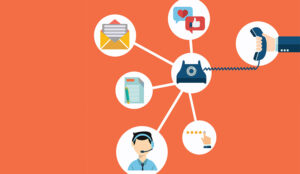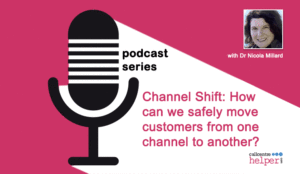Our panel of experts reveal the best ways to implement a true ‘channel of choice’ experience.
Think carefully about how you respond to your customers
Think carefully about how you respond to your customers – just because they emailed you to ask a question, for example, doesn’t mean it’s best to reply by email too. A phone call is usually quicker and cheaper.
For maximum efficiency, once you’ve got your customer history and management information, program an automated dialler to make or receive and route calls in the most effective way for your business.
Research your customers’ channel preferences

Ken Reid
Customers will choose to communicate via the channel that is the cheapest, the quickest, the most effective – or the most painless for them – depending on their age and circumstances.
You should ensure that you really know your customers by carrying out proper research – their profile, how and when they like to be contacted, etc. – and building up a single view of them using an appropriate system such as CRM.
This may sound costly and time consuming but it’s definitely one case where short-term pain will provide long-term gain.
With thanks to Ken Reid at Rostrvm Solutions
Empower your agents to switch channels if the situation escalates

Carolyn Blunt
It is helpful if things start to escalate or get too complex that the channel can change, for example from social to webchat or email; or from email to phone.
Too often I work with advisors who ‘are not allowed’ to change channels. This is frustrating for them and does not give the customer continuity of experience, as (even with good system notes) the customer will still feel the need to retell their story.
This is not only increasing the effort on the customer’s part but psychologically, every time they retell the story, they are also reliving it. This is not good when it comes to satisfaction scores – and also makes them more ‘fluent’ in retelling the story to others.
Allow your advisors the freedom to make an outbound call to the customer if that’s what the customer wants or common sense dictates. It is one of the best way to de-escalate situations – just ensure your advisors are properly trained in the slightly different skills needed across each channel.
With thanks to Carolyn Blunt at Real Results Training
Consider the impact of new digital channels upon your front-line staff

Jaime Scott
Your front-line staff are more likely to be dealing with more complex enquiries and complaints, as well as failed online transactions, so it is vital that they are empowered to deal with them.
An outstanding multichannel customer experience should be a win–win for customers and contact centre staff – but the foundation of insight and agent motivation needs to be in place first.
Don’t push your customers into choosing self-service
There is a growing trend towards enabling customer self-service through digital channels; however, it is important that customers don’t feel pushed into using self-service channels without being able to select a preference.
Being able to capture real-time customer feedback across any channel can help to inform your multichannel strategy.
Like any strategic programme, self-service requires careful planning to meet the needs of both customers and your front-line staff who are increasingly orchestrating the multichannel dialogue.
Put emphasis on resolving every customer query via their first contact
A dissatisfied customer may resort to social media channels to ensure they are given priority.
You can help to overcome this by putting a high emphasis on resolving every customer query via their first contact. For example, putting greater emphasis on qualitative goals such as FCR alongside traditional call centre metrics.
With thanks to Jaime Scott at EvaluAgent
Track all customer communications across all channels in real time

James Glasspool
Leverage your customer CRM system to properly record and track all customer communications across all channels and in real time.
In addition, you should be able to use your CRM system to record your customers’ preferences for how they wish to be contacted so supporting your agents in making the right choice when they want to reach out to a customer.
Ensuring that all of the contact centre communication history is tracked against each customer record also ensures that the agent can be much more effective in properly understanding any customer issues before they make that call, or write that email or reply to a tweet.
This consolidated view also ensures organisations don’t provide the same template-based answer to a customer which may have already been used, but can personalise the response for a much better customer engagement.
Review response targets – especially for email
In this multichannel world, organisations should be setting more responsive targets. Why do so many organisations set a 24-hour or worse response target for emails?
I would recommend reviewing all of your target response times across all channels to see if they make sense from your customers’ perspectives.
With thanks to James Glasspool at VoltDelta International
Make sure you fully understand your customers’ preferences

David Ford
Your customers’ channel choice will be based on a number of factors, including the nature of the enquiry, which device your customer is choosing and, of course, demographics as well.
While your long-term customers may still prefer traditional channels, younger customers are probably used to ‘channel hopping’ and will expect you to be too.
Once you understand customer preferences, you can set performance targets accordingly and ensure that you allocate resources effectively and empower your agents to meet customer expectations.
For example, keeping the tone light and friendly on chat, being ready to handle complex enquiries by telephone and resolving as many email queries as possible first time to prevent the issue escalating to a frustrated call into your contact centre.
Define clear goals before creating your channel of choice experience
It is vital that you understand what your contact centre is aiming to achieve – whether that is an increase in customer satisfaction and long-term loyalty, more successful first call resolution, or brand differentiation in a competitive marketplace.
Once you have defined clear goals, you can set about creating a channel of choice experience that adds value to your organisation’s bottom line while avoiding unnecessary IT spending.
Your agents need to know if that customer just called in
You need a single view of the customer contact history across all channels or your channel of choice strategy will always be compromised.
For example, your agents need to know that the irate customer who has just called in with a genuine complaint actually emailed you five days ago but received no response.
Too many channel of choice strategies fail because of technology limitations.
With thanks to David Ford to Magnetic North
Joined-up leadership is just as important as having the right technology

Matt Dyer
The challenge lies in structuring and running customer service operations to make a true multichannel customer experience achievable.
At present, we still see a lot of inconsistency between the roles and interface between the digital/online function, contact centres and marketing.
All these people want to design and offer the best customer journeys they can, but they often find this is thwarted by the absence of truly joined-up digital customer service leadership.
Appointing a Chief Digital Officer (CDO) or equivalent role can help to bring some clarity to the end-to-end customer journey.
With thanks to Matt Dyer at Sabio
Self-service options should link seamlessly to an agent where necessary

Dave Paulding
The use of automated, self-service options can be particularly helpful in delivering consistency. This includes giving customers intelligent options to choose from, choices that reflect their actual needs, such as detailed, easy-to-use IVR menus or dropdowns on a website contact page.
Importantly, if the option selected by the customer doesn’t resolve their query, they should be seamlessly transferred to an alternative channel. The agent receiving the query should be immediately informed as to the nature of the query and what the customer is looking for. Repeating information or starting from scratch will only frustrate the caller and decrease the possibility of a favourable customer experience outcome.
Training and technology are important for delivering a consistent experience
The choice of channel depends largely on the consumer’s preferences, age and reason for contact.
Regardless of the ‘why’, it is the ‘how’ that becomes vital for a contact centre. For example, how does a business ensure customers are receiving a consistent, high quality experience?
The integration of all channels into the same platform is a good place to start. However, the contact centre should have the trained agents and appropriate technology and systems in place to ensure that the customer can be assured of the same experience across all channels.
With thanks to Dave Paulding at Interactive Intelligence
Create teams according to their expertise – not channel speciality

Susannah Richardson
You can help to create consistent customer service across multiple channels by creating teams according to their expertise and knowledge rather than channel speciality.
Many contact centres create teams according to channel type, e.g. an email team, social media team, etc., which means customers aren’t being forwarded to the agent who can best help them with their enquiry.
Introducing multichannel agents, who deal with customer service across multiple channels, but specialise in specific product or service knowledge means the contact centre can provide a much more consistent customer service across all available channels.
Integrate the contact centre with back office-applications and databases
Contact centres can implement a true channel of choice experience by having a solution that can manage multimedia in a single universal queue (including voice, email, click-to-chat, fax, SMS, web and social media), rather than agents having to deal with piecemeal technology and legacy systems that are disparate and complex.
This type of technology can also integrate with back-office applications and databases such as CRM and ERP to automate actions and processes and eliminate inefficiencies across the business.
Implementing this type of technology allows customer enquiries to be not only routed to the most appropriate and skilled agent, but also prioritised in terms of customer need, not channel.
With thanks to Susannah Richardson at mplsystems
A unified queue can help manage all channels equally

Chris Key
A single, unified queue can enable your business to provide an improved service to all your customers.
With all of your communications flowing into the contact centre through a single queue – which prioritises all channels equally – you can ensure each enquiry is handled as quickly as the next, and with an equally high level of service.
Further advantages of a unified queue include:
- Detect and respond to complaints on Facebook and Twitter before they escalate.
- Deliver automatic responses to frequently asked questions by detecting keywords in tweets.
- Handle more enquiries outside business hours with fewer staff, by concentrating on email, social networks and chat facilities, instead of a telephone line.
- Agents can respond to deaf customers equally efficiently, such as through the use of video sessions for agents skilled in sign language.
This system can also help you to build a profile of channel usage based on the time of day – and help you structure your resources to best manage customer service.
With thanks to Chris Key at Hostcomm
Different channels are needed for different things

Andrew Mennie
Social media platforms such as Twitter, Facebook, LinkedIn are often turned to, while email, mobile chat and even the phone call are relied upon by different customers requiring different things.
If your digital experience is not offering access to each of these channels more than a trick is being missed.
Don’t overlook the timing and relevance of your offerings
It is too common for a contact centre to offer blanket support regardless of a customer’s place within their journey, but then fail to support the need.
Not only should different channels be provided, but also different accessibility to each channel, in terms of timing and relevance to the customer’s situation. For example, is self-service search easy to locate and navigate for the incoming visitor?
Both the right solution and the right engagement strategy are required to offer a fulfilling customer experience over a combination of channels that doesn’t fall short.
Reading digital ‘body language’ goes beyond just provision of channels, it provides a service that anticipates customer intent and proactively interacts with them, and one that is also able to provide the right answer to meet the customer’s needs.
With thanks to Andrew Mennie at Moxie
Make use of the customer data stored in the CRM
Today’s customers are constantly changing their preferred contact channel based on where they are and what they’re doing.
Businesses should use the rich customer data stored in their CRM system to make intelligent decisions on how to handle, treat and route customer interactions – regardless of channel.
With thanks to Jonathan Gale at NewVoiceMedia
Make sure that your WFM system properly supports multichannel
Forecasting and scheduling for ‘new media’ are completely different from planning for inbound calls. Ensure that your WFM solution can forecast the requirements for each channel – and schedule correctly.
It should also be able to monitor patterns and trends, identify skill gaps and support continuous improvements, which in turn can improve cost efficiency and find new ways to optimise the customer experience.
The ability to switch channels without restarting the conversation
If customers start a conversation on one channel, they expect to be able to complete it on another channel without having to restart.
Before adding new channels to deliver customer service, think about how your contact centre can support customers to ensure consistency. If your contact centre can provide seamless and consistent experiences across multiple channels, you will earn your customers’ trust and loyalty.
With thanks to Chris Dealy at injixo
Offer automated self-service and call-backs via the IVR

Dave Ogden
The development of automated self-service from IVR – including the answers to FAQs – has helped bridge the gap between self-service and more complex queries.
This is because it has the capabilities to resolve queries through automation to a point, as well as allow customers to be transferred or request call-backs with a fully informed agent.
With thanks to Dave Ogden at Aspect Software
Move away from silos to maximise the customer experience
Customers are now faced with a deluge of ways to reach the customer service department. The problem is many of these channels are staffed by a team of agents responding solely to interactions within their channel. These channels then become individual ‘information silos’ where little or no customer data is shared.
A typical customer journey may go something like this: a customer contacts your business via social media with a query or complaint, the social media team then advises the customer to contact the organisation’s phone-based agents. The phone agents are then completely unaware that the customer has already relayed their complaint once, and ask them to repeat it.
As well as being inefficient, the customer is the one making all the effort. With no shared customer information because of the silo effect, departments have no way to escalate or understand a customer’s end-to-end journey through the interaction process.
Understand how each customer uses your channels

Richard McCrossan
Understanding how each customer uses channels is key to improving customer engagement and sales, as tracking cross-channel behaviour can allow a contact centre to build up customer profiles.
Agents can then take a proactive role in customer outreach, providing the personal touch which can improve customer loyalty. Higher loyalty means less defection to competition and can increase sales.
Management can also benefit from customer journey mapping to optimise staffing needs and react to consumer developing trends in or between channels.
With thanks to Richard McCrossan at Genesys
How do you create a true ‘channel of choice’ experience in your contact centre?
Author: Megan Jones
Published On: 17th Dec 2014 - Last modified: 13th Jan 2025
Read more about - Technology, Alvaria, Carolyn Blunt, Chris Dealy, Customer Experience (CX), David Ford, EvaluAgent, Genesys, Hostcomm, IFS, Intrado, Jonathan Gale, Ken Reid, Moxie Software, Omnichannel, Peopleware, Richard McCrossan, Rostrvm, Sabio, Susannah Richardson, Vonage





















